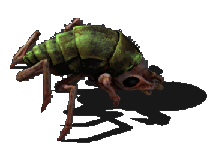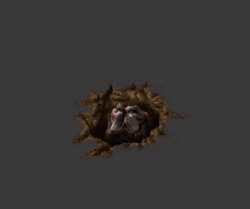敌人
敌对生物就是想要来干(危害)玩家的生物。敌对生物分为三种:食人虫,喷吐虫和沙虫。每种敌对生物都有三个成长阶段。
生物
食人虫
食人虫是两种主要的敌人之一。它们是外星世界的原住民,不会与喷吐虫和沙虫打架。食人虫是节肢动物,生活在虫巢中。它们有三种尺寸:小,中,大。在自由模式开局时,只会生成小的。但是随着污染的增加,它们的等级会提升。这与 进化有关系。 食人虫会被污染所吸引与激怒,因此它们会试图摧毁污染源。它们在看到玩家,防御塔以及物流机器人时,会转而攻击他们。 食人虫会给玩家造成身体伤害。
| 图片 | 名字 | 资料 |
|---|---|---|
| File:SmallBiter-anim.gif | 小型食人虫 | 最弱的食人虫,能被手枪轻松击杀。
|
| File:MediumBiter-anim.gif | 中型食人虫 | 比小型食人虫更肉也更慢。它们可能造成一些问题,有时它们甚至可以击杀弱小的玩家。
防御:
|
| File:BigBiter-anim.gif | 大型食人虫 | 很肉, 几乎对枪击无敌。他们几乎能直接破墙并攻击其后的东西。
防御:
|
 |
巨型食人虫 | 很肉, 几乎对枪击无敌。他们几乎能直接破墙并攻击其后的东西。
防御:
|
战斗
食人虫是对玩家工厂最常见的威胁。虽然他们的每次攻击都足以摧毁不设防的工厂,但大多数玩家能够在于小型食人虫的战斗中占据上风。它们也能被一定数量的防御塔阻挡。
污染会引起食人虫攻击,高污染工厂会更早地受到攻击。一旦污染范围达到了虫巢,玩家就能预见食人虫就会在很短的时间内出现。虫群会致力于摧毁污染源。但当遇见更有诱惑力的目标(玩家与防御塔)时,它们也会改变进攻计划。食人虫也有在防御圈上趁虚而入的能力。这一特性能部分用于控制食人虫的路径,使得防御塔有更长的攻击时间,但这个陷阱需要"诱饵"。 食人虫们不总会掉到圈套里。一些“聪明的”虫子会看透陷阱,并直接攻击你的墙。这会使你的陷阱失效,也使得食人虫们更加危险。
喷吐虫
除了它们的外表,喷吐虫与食人虫很像。它们唯一的不同点是攻击地点不等。他们会向所有对手(例如:玩家)喷吐不可闪避与被转移目标的酸球。通常,建筑物(例如炮塔与护甲)的酸液防御能力要比物理防御能力低得多,因此喷吐虫造成的平均伤害会比食人虫高。除了它们的血量与防御不同,它们的大小与行为与对应的食人虫很像。
| 图片 | 名字 | 信息 |
|---|---|---|
| File:SmallSpitter.png | 小型喷吐虫 | 最弱的喷吐虫。能在其射程外轻松被任何一种武器轻松击杀。
|
| File:Mediumspitter anim.gif | 中型喷吐虫 | 比小喷吐虫更慢也更肉了。它们可能造成一些问题,有时它们甚至可以击杀弱小的玩家。远程攻击,使得它对防御塔十分危险。
防御:
|
| File:Bigspitter anim.gif | 大型喷吐虫 | 它是次大的喷吐虫,也能造成次大的伤害。远程攻击使得它对防御塔以及玩家造成了巨大的威胁。
防御:
|
| File:Behemothspitter anim.gif | 巨型喷吐虫 | 它是最大的喷吐虫,也能造成最大的伤害。远程攻击使得它对防御塔以及玩家造成了巨大的威胁。
防御:
|
沙虫
沙虫是一种自然的攻击性动物。如果你离它足够近,他会喷出东西来杀死你。 他们像静态的 炮塔 且不会跟随你, 但是攻击范围比其他虫子大得多。在离开巢穴时会造成伤害。 但不管怎么说,因为它们是静态的,所以使得他们更容易遭受攻击。
跟别的虫子一样,沙虫也有3种大小,它们的攻击力随着大小的增加而增加。 不像食人虫和喷吐虫, 大型或中型的沙虫可以直接地被生成于创建世界之时, 而且不是在虫巢生成的. 它们的表现不会根据时间的变化而变化. (具体请查看 http://www.factorioforums.com/forum/viewtopic.php?f=23&t=6454)
| 图片 | 名字 | 信息 |
|---|---|---|
| File:SmallWorm.png | 小型沙虫 | 非常菜鸡的沙虫,但还是不太容易被搞死。
|
| File:MediumWorm.png | 中型沙虫 | 中型沙虫非常危险,甚至可以对相对经过更长时间磨炼的玩家造成伤害,应该小心对待它们。
防御:
|
| File:BigWorm.png | 大型沙虫 | 大型沙虫是Factorio中最强的生物了。它们可以造成很高的伤害,不是那么容易被普通武器造成伤害。
防御:
|
| Picture | Name |
|---|---|
 |
沙虫动画 |
巢穴
| 图片 | 名字 |
|---|---|
| File:Nest.gif | 食人虫巢穴 |
| File:Spitternest.gif | 喷吐虫巢穴 |
进化
进化因子是游戏的全局设定之一,它决定了会生成什么样的虫子。 你可以在调试控制台查看这个变量:
game.player.print(game.evolutionfactor)
它从0开始 (根本不进化) to 1 (最大进化). 目前进化因素只能增加。这一演变因素增加了三种事件:
- 时间的流逝稍微增加了进化因素。
- 污染的产生(全局)增加了进化因素。
- 攻击虫子会产生很大的进化因素。
这些值都在地图设定中。它们也可以被改变或被mod改变。
The default settings are:
| Source per | Variable in enemy_evolution
|
Percent increase |
|---|---|---|
| Second | time_factor |
0.0004% |
| 1000 Pollution Units | pollution_factor |
0.0015% |
| Destroyed enemy spawner | destroy_factor |
0.2% |
Pollution production is the total pollution produced by buildings per tick, not the pollution spreading on the map, so it is not reduced by trees or other absorbers. e.g. : 15 burner mining drills produce 150 pollution per second, raising the evolution factor by 0,00000225 per tick.
The percentages are applied on the base of 1 - current_evolution_factor. So for instance destroying enemy spawners in the beginning of the game results in increase of evolution factor by 0.005 (half a percent) while doing this when the evolution factor is 0.5 the increase is only 0.0025 (quarter a percent).
Besides choosing what kind of biter will be spawned the evolution also influences the spawning interval. This interval (spawning_cooldown in the enemy-spawner definition) is interpolated between 360 (0 evolution) and 150 (1 evolution) ticks.
Spawn chances by evolution factor
| Biter's Nest | ||||
|---|---|---|---|---|
| Factor | Small Biter | Medium Biter | Big Biter | Behemoth Biter |
| 0% | 100% | |||
| 5% | 100% | |||
| 10% | 100% | |||
| 15% | 100% | |||
| 20% | 100% | |||
| 25% | 82% | 18% | ||
| 30% | 67% | 33% | ||
| 35% | 53% | 47% | ||
| 40% | 40% | 60% | ||
| 45% | 29% | 71% | ||
| 50% | 18% | 82% | ||
| 55% | 8% | 80% | 12% | |
| 60% | 79% | 21% | ||
| 65% | 63% | 37% | ||
| 70% | 38% | 62% | ||
| 75% | 33% | 67% | ||
| 80% | 29% | 71% | ||
| 85% | 26% | 74% | ||
| 90% | 24% | 76% | ||
| 95% | 16% | 59% | 25% | |
| 100% | 13% | 50% | 37% | |
| Spitter's Nest | |||||
|---|---|---|---|---|---|
| Factor | Small Biter | Small Spitter | Medium Spitter | Big Spitter | Behemoth Spitter |
| 0% | 100% | ||||
| 5% | 100% | ||||
| 10% | 100% | ||||
| 15% | 100% | ||||
| 20% | 100% | ||||
| 25% | 100% | ||||
| 30% | 42% | 58% | |||
| 35% | 100% | ||||
| 40% | 100% | ||||
| 45% | 83% | 17% | |||
| 50% | 75% | 25% | |||
| 55% | 54% | 36% | 10% | ||
| 60% | 35% | 47% | 19% | ||
| 65% | 17% | 56% | 27% | ||
| 70% | 65% | 35% | |||
| 75% | 56% | 44% | |||
| 80% | 45% | 55% | |||
| 85% | 35% | 65% | |||
| 90% | 24% | 76% | |||
| 95% | 16% | 59% | 25% | ||
| 100% | 13% | 50% | 37% | ||
Expansions
Sometimes a small group of biters will leave their base to create a new base. This group will search for a suitable spot that's about 3 chunks away from existing biter bases and 3 chunks away from any of your buildings. Once they have found a suitable spot the group of biters dies and forms a new base. This new base will first be very small (about one spawner and a few worms) but will get some additional spawners within a small area as time passes. This base-wide expansion is somehow limited (the blog says something about 7, but that doesn't seem to match reality in some cases).